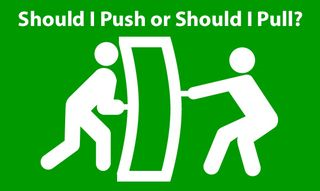Should I Push or Should I Pull?
Oh the clash… should I push or should I pull? If I pull out all the stops will I be pushing the envelope? If I push myself to the limit will I pull a muscle? If I pull my punches will I be a pushover?
When it comes to manual material handling, rather than pull my hair out in vexation, I think I’ll push the question over to the experts in the Biodynamics Laboratory at The Ohio State University.
In their published article, Spine loading at different lumbar levels during pushing and pulling, researchers Gregory S. Knapik and William S. Marras studied both compressive and shear forces (anterior-posterior and lateral) at each level of the lumbar spine during pushing and pulling activities. Using a subject population of 10 male and 10 female university students with no history of low back pain, an assessment was conducted on horizontal pushing and pulling exertions at three handle heights (50%, 65%, and 80% of subject stature) and three handle force levels (20%, 30%, and 40% of subject body weight). Employing an electromyography-assisted biomechanical model, each subject wore a lumbar motion monitor while performing controlled pushing and pulling motions to collect the data in order to predict spine loading.
Of significance, the results of the study indicated the following:
- Compressive forces were greater in pulling compared to pushing throughout the lumbar spine
- Compressive forces were lowest for both pushing and pulling at the medium (65% of stature) handle height and greatest for pushing at the low handle height (50% of stature) while greatest at the high handle level (85% of stature) when pulling
- Anterior-posterior (A/P) shear forces were greatest for pushing as compared to pulling along the lumbar spine except at L5/S1 where they were roughly the same
- A/P shear forces were greatest at the upper lumbar levels when pushing at a handle height of 50% and pulling at 80% of stature
While pushing is generally preferred over pulling, the authors state in the article’s discussion section that “Collectively, these analyses suggest that pushing and pulling activities are not as intuitive as once thought and the risk to the low back occurs at lumbar levels that have been previously underappreciated.”
I guess I’ll push on and pull back only when needed.
Check out the Ergonomics section of the MEMIC Safety Director for a streaming video and booklet on back injury prevention.
Reference: Knapik, Gregory G. and Marras, William S. (2009) ‘Spine loading at different lumbar levels during pushing and pulling’, Ergonomics, 52: 1, 60-70


